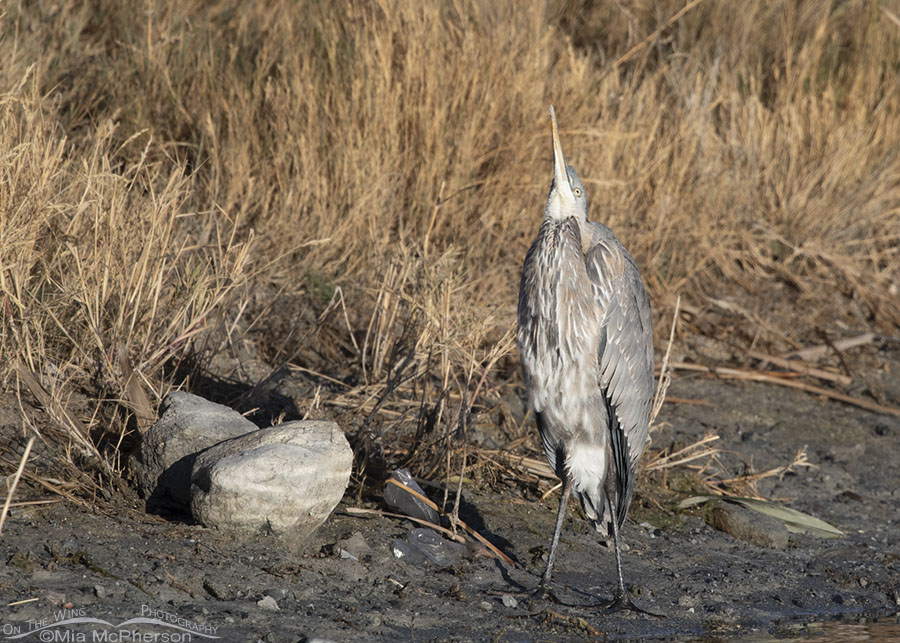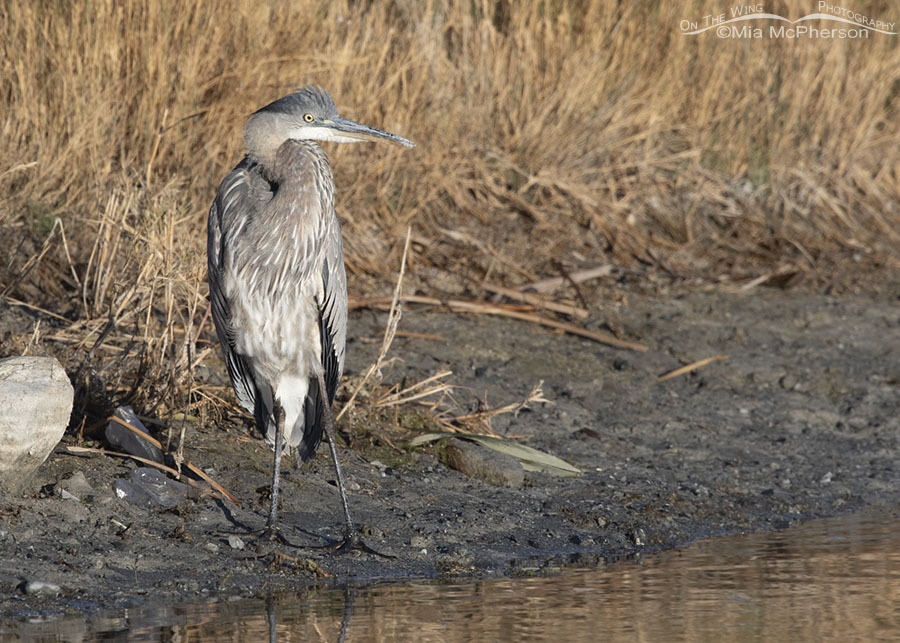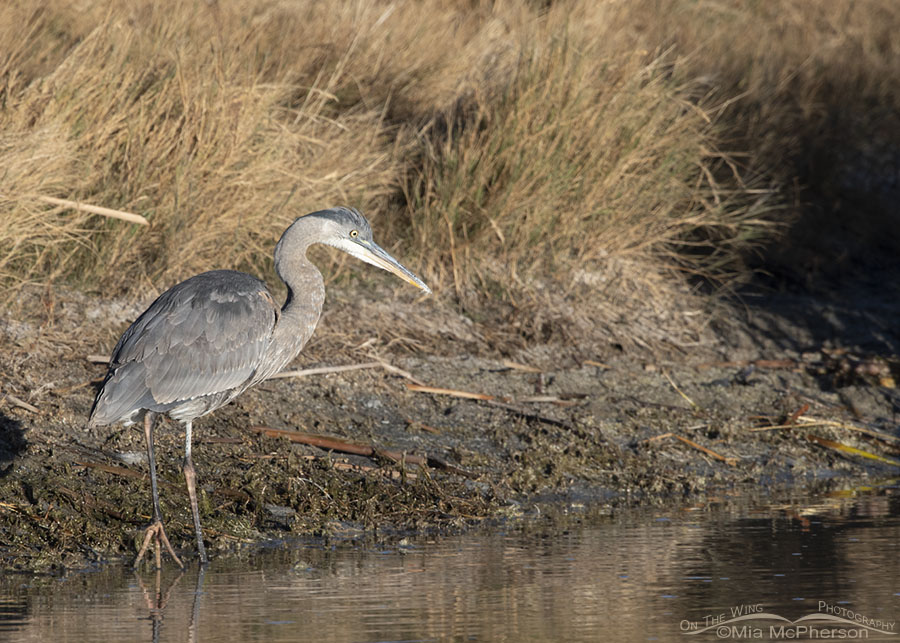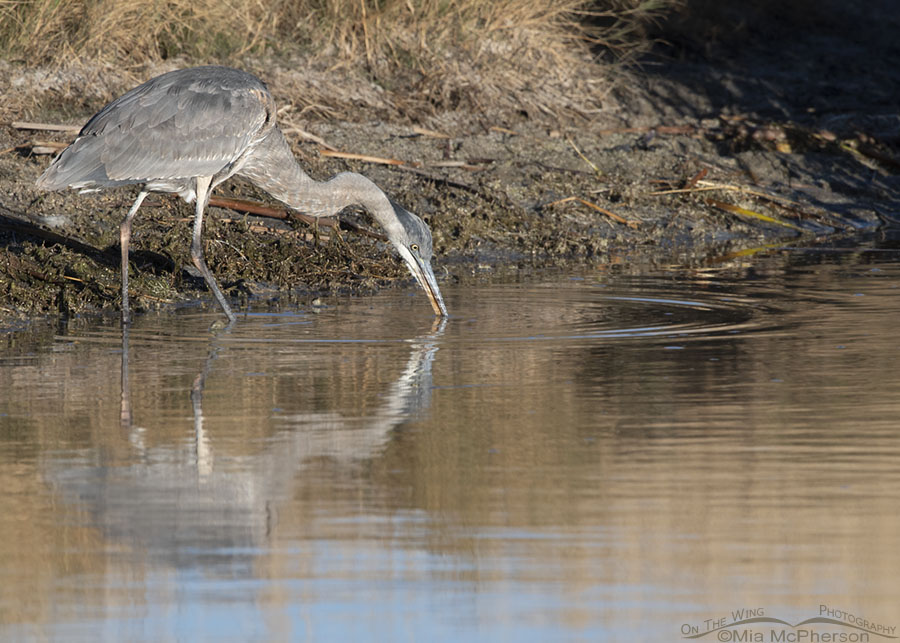 Immature Great Blue Heron with its eyes on the sky overhead – Nikon D500, f7.1, 1/2000, ISO 500, Nikkor 500mm VR with 1.4x TC, natural light
Immature Great Blue Heron with its eyes on the sky overhead – Nikon D500, f7.1, 1/2000, ISO 500, Nikkor 500mm VR with 1.4x TC, natural light
Three days ago I spotted an immature Great Blue Heron resting at the edge of the water at Farmington Bay WMA and couldn’t resist taking photos of it. I almost giggled out loud when the young heron looked up at the sky overhead because it seemed like it was mimicking the pose I often see American Bitterns take in the marshes here.
I am fond of photographing Great Blue Herons here in northern Utah because they are so dinosaur-like in appearance. These herons appear to be so prehistoric that they could have stepped directly through the mists of time into the present. For some reason that tickles me.
Great Blue Herons aren’t nearly as approachable in northern Utah as they were for me in Florida where they are far more used to human presence so when I have one within reach of my long lens I jump at the opportunity to photograph them.
 Immature Great Blue Heron next to the water at Farmington Bay WMA – Nikon D500, f7.1, 1/2000, ISO 500, Nikkor 500mm VR with 1.4x TC, natural light
Immature Great Blue Heron next to the water at Farmington Bay WMA – Nikon D500, f7.1, 1/2000, ISO 500, Nikkor 500mm VR with 1.4x TC, natural light
I’ve been asked many times how I identify Great Blue Herons as immature, juveniles or young. In this photo the crown on this immature Great Blue Heron isn’t as dark as an adult’s crown would be is one way. The striping on the neck and upper chest of a young Great Blue Heron is more profuse that it would be on an adult is another.
 Immature Great Blue Heron foraging for breakfast – Nikon D500, f7.1, 1/1250, ISO 500, Nikkor 500mm VR with 1.4x TC, natural light
Immature Great Blue Heron foraging for breakfast – Nikon D500, f7.1, 1/1250, ISO 500, Nikkor 500mm VR with 1.4x TC, natural light
This immature Great Blue Heron started to walk along the shore as it foraged for breakfast. The young heron picked up a dead bullfrog tadpole several times but always dropped it back into the water. I’m not sure why it didn’t eat it. Maybe the tadpole was rotten. In my photos the tadpole looked like it was partially decomposed and slimy.
 Immature Great Blue Heron with its bill in water – Nikon D500, f7.1, 1/1250, ISO 500, Nikkor 500mm VR with 1.4x TC, natural light
Immature Great Blue Heron with its bill in water – Nikon D500, f7.1, 1/1250, ISO 500, Nikkor 500mm VR with 1.4x TC, natural light
As I photographed this immature Great Blue Heron I thought about it facing its first winter here in northern Utah and about how it would face bitter cold, snow, long winter nights and iced over water. These herons are tough but their first winter is rough on them. It is my hope that this young Great Blue Heron survives and thrives.
Life is good.
Mia
Click here to see more of my Great Blue Heron photos plus facts and information about this species.


Your first paragraph made me laugh out loud! I see lots of Great Blue Herons here on the Eastern Shore of Maryland. When they are flying you can tell they are Herons the way their long legs stretch out behind them. My husband and I both comment they look like dinosours!
My favorite photo is of the her on drinking the water. I love reflective photos!
They do indeed show signs of their ancestry but pelicans take the prize for ‘most’ dinosaur like for me.
It just looks young, would be my reply, so thanks for enlightening me.
They are often very patient and wait for the fish to come to them, but I once saw one actually swim out like a big swan when the lake seemed to be just full of small fish. Agree with April that its call can be loud and spooky, definitely from another time and place!
They are very much like dinosaurs. I even imagine their croaky call dinosaur like.